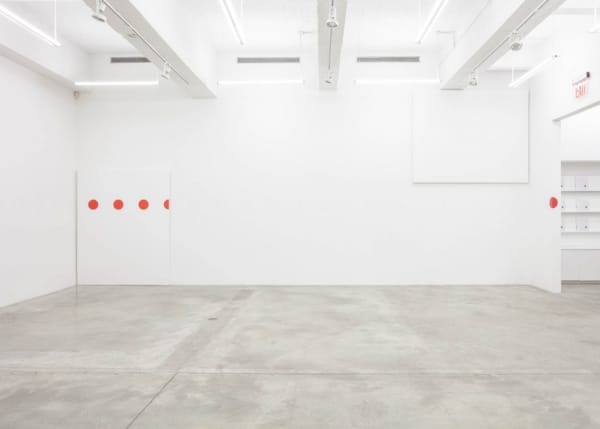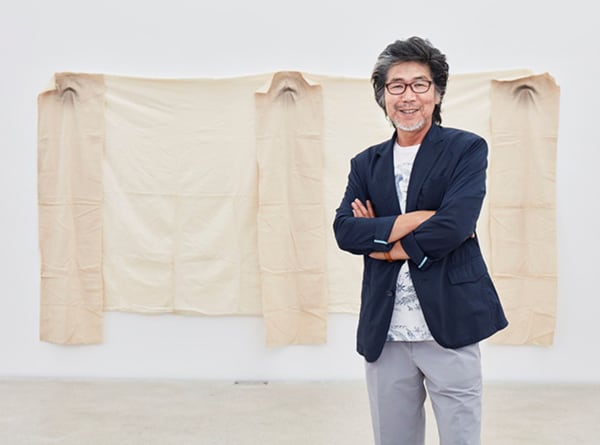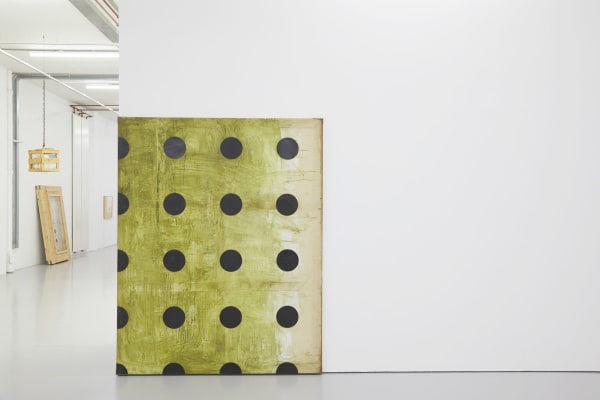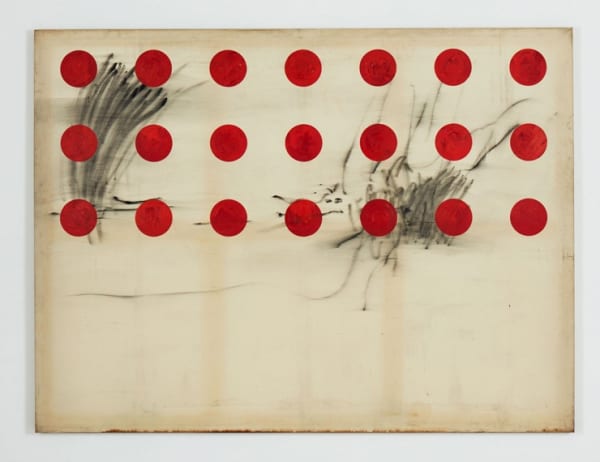Kim Yong-Ik: Solo Exhibition
Artist Talk Presented by Asia Art Archive: Friday, May 5, 2017 | 6:30PM Chelsea Arts Tower | 545 W 25th St
Tina Kim Gallery is pleased to present the first solo exhibition in the United States of Kim Yong-Ik (b. 1947), on view from April 27 through June 17, 2017. The exhibition focuses on three key periods of the artist’s career: his Plane Object series of fabric works from the 1970s, his geometric compositions from the 1980s, and his dot paintings from the 1990s. Rooted in modernist painting, Kim’s self-reflective practice questions the relationship between the avant-garde and society. Maintaining an independent stance amidst Korea’s dominant artistic movements—from the modernism and conceptualism of the 1970s to the Minjung (populist) art movement of the 1980s—Kim uses the medium of painting as a starting point for unveiling both the structure and the contradictions of modern art and its institutions.
As a student, Kim Yong-Ik briefly studied agriculture and life sciences at Seoul National University before transferring to Hongik University to study in the school’s renowned oil painting department. There, he worked and studied under Park Seo-Bo, a figurehead of the country’s Dansaekhwa movement, who exerted strong influence on the South Korean art scene at the time. Kim’s group and solo exhibitions after graduating all focused on his Plane Object series, which features spans of cloth of roughly human scale that are stained, creased, and then displayed directly on the gallery walls without a frame. By spray- painting the cloth while it is stretched or hung, Kim creates trompe-l’oeil contours on the cloth that contradict the surfaces’ actual shadows when it is exhibited. The series incorporates aspects of Dansaekhwa’s interrogation of a painting’s surface and material; Kim transforms the two-dimensional plane of the painting into an ordinary, three-dimensional object, highlighting its material imperfections.
In 1981—at the beginning of the Chun Doo Hwan administration, infamous for its brutal suppression of pro-democracy movements—Kim was invited to exhibit at the 1st Young Artists Exhibition held at the National Museum of Contemporary Art, Seoul. While the intent was to exhibit the Plane Object series, Kim decided to leave the works tightly enclosed in their cardboard shipping boxes, labeled with pieces of paper listing the title, dimension, and materials of the works. The boxes—used, taped-up, and dirty—were shown propped up against the walls of the exhibition hall. While some denounced this decision, Kim’s gesture coincided with a larger backlash against modernist painting with the emergence of the Minjung art movement. However, whereas the Minjung movement opposed the austerity of modernist painting with its embrace of vivid figuration and ephemerality, Kim forged an independent response, collapsing the painting in on itself and drawing the viewers’ attention to all of its packaging, both literal and figurative. In the following years, Kim continued to withdraw from the concerns of the Minjung movement by focusing on more formalist compositions that favored a clean, sharp-edged geometry.
In the 1990s, Kim turned his focus to a new series: his dot paintings, which feature the repetition of regularly-spaced circles. While these paintings share the seriality and overall composition of the works of Kim’s predecessors—such as Park Seo-Bo and Kwon Young-Woo—the uniformly-placed crisp dots have a mechanical quality that defies the manual or the “natural” methods employed by these other artists. The canvases themselves are often in a state of deterioration, covered in scribbled notes, stains, and sometimes mold. The works echo a set of standards that Kim had outlined for his art a few years earlier— a work of art should be simple and cheap to produce, and “a good artwork would be okay even if it’s a bit torn or soiled or broken."[1]
[1] “Untitled”, General Financial Monthly, February 1987
Kim revisited some of his dot paintings in the 2000s, altering and presenting them in new ways. In 2005, for instance, Kim began to modify Closer... come closer... (1995)—a painting of blue dots, one of several works with the title—by first adding a rough pencil sketch of his body to the canvas. Then, from 2009 to 2010, he left the modified work outside of his studio for a year, where it accumulated natural damage from weather. After taking the painting back inside, he added a design in glittering gold paint and affixed gold- painted bedposts to the work in a kitschy take on a reliquary or an altarpiece. The work was soon vandalized by children while being shown at an exhibition at the Seoul Museum of Art, an event that Kim celebrated. After this incident he framed the work behind glass, rechristened it Bidding farewell to you..., and inscribed on the surface of the glass a text recounting the painting’s history. In the text he describes, “[through its vandalization] the work has finally been completed. It was the completion of death! I incorporate the audience’s ‘damage-drawings’ as part of the work, and lay it in a glass casket at last. Now it is time to enshrine this work in a museum.”[2] Kim has continued to make works in a similar vein, as in his recent “coffin” series, in which he repackages his works, adorns them with text, and gives them a funeral or burial in the form of an exhibition.
[2] Text from Bidding farewell to you... (1995-2012), re-printed in Kim Yong-Ik, Kukje Gallery, 2016
Similar to Kim’s 1981 exhibition at the National Museum of Contemporary Art where he showed Plane Object still wrapped up in its shipping boxes, Kim’s treatment of his dot paintings demonstrates the ways in which he draws attention to aspects of a work of art that had been ignored by modern painting, in particular the artworks’ interaction with its environment and the institutions in which it is embedded. In recent years Kim has continued to explore these concerns through his engagement with public and environmental art, as both an artist and a critic. After relocating to rural Yangpyeong in 2000, Kim led the public art project Yangpyeong Project (2000) and has participated in many other public and environmental art projects including the Geumgang Nature Art Biennale (2010) and the first Land Art Mongolia 360° (2010). Through such endeavors, Kim continues to create art that serves not as an escape from the world, but rather as a platform for critical engagement with our surroundings.
Tina Kim Gallery is thrilled to announce Kim Yong-Ik's recent acquisition by the Los Angeles County Museum of Art, purchased with funds provided by AMOREPACIFIC Corporation
ARTIST TALK PRESENTED BY ASIA ART ARCHIVE
Art Space Pool: A History with Kim Yong-Ik, Sunghee Lee, and Sohl Lee
Friday, May 5, 2017, 6:30PM | Chelsea Arts Tower, 545 W 25th Street, 3rd fl., New York, 1001
Co-founded in 1999 by twenty local artist-curators, art critics, and interdisciplinary writers and thinkers, Art Space Pool in Seoul, South Korea is a non-profit art organization with the mission of initiating contemporary art productions and fostering cultural discourses and ideas. In this talk, Art Space Pool co- founder Kim Yong-Ik and current director Sunghee Lee, will focus on Pool's history from the early years to the present, as well as their own artistic and curatorial evolution. The presentation will be followed by a discussion moderated by scholar Sohl Lee, which will examine the original mission that remains embedded in the name "Pool": a meeting of people sharing a critical mindset.
ABOUT THE ARTIST
Kim Yong-Ik was born in 1947 in Seoul and currently lives and works in Yangpyeong, South Korea. From 1999 to 2012, Kim was a professor in the Painting Department of Gachon University (formerly Kyungwon University)’s College of Art and Design. He is also a founding member of Art Space Pool, an alternative space established in Seoul in 1999, where he served as the director from 2004 to 2006. Kim was the subject of a comprehensive retrospective that examined his 40-year-long practice at Ilmin Museum of Art in Seoul in 2016. His work is included in a number of public and private collections including Leeum, Samsung Museum of Art (Seoul), Tokyo Metropolitan Art Museum, the Museum of Contemporary Art Los Angeles and the Los Angeles County Museum of Art.
-

Kim Yong Ik – Speaking to a Latter Genesis
COBO Social June 11, 2019By Bansie Vasvani Kim Yong-Ik never fails to surprise his audience. In his second solo exhibition, “Speaking of Latter Genesis,” 2019, at Tina Kim Gallery,...Learn More -

Three exhibitions to see in New York this weekend
The Art Newspaper May 23, 2019[...] Head inside to Tina Kim Gallery to see the ultimate version of “site-specific work” in a solo show of the Korean artist Kim Yong-Ik,...Learn More -

In Conversation with Elliat Albrecht - Kim Yong-Ik
Ocula May 23, 2018In Conversation with Elliat Albrecht Kim Yong-Ik is the understated rebel of the Korean art world. Over his 40-year career as an artist, writer, and...Learn More -

Kim Yong-Ik Korean Cultural Centre, London, and Spike Island, Bristol, UK
Frieze October 25, 2017By Tim Smith Laing It is easy to look at Kim Yong-Ik’s best-known motif – the repeated polka dot, often on a plain background –...Learn More -

Korean Artists Recognized Overseas
The Korea Times June 6, 2017By Kwon Mee-yoo Two established Korean artists, Kim Yong-ik and Chun Kwang-young, are holding solo exhibitions overseas, showcasing contemporary Korean art rooted in the nation's...Learn More -

Kim Yong-Ik at Tina Kim Gallery, New York
ARTnews May 10, 2017“Kim Yong-Ik: Solo Exhibition” is on view at Tina Kim Gallery in New York through Saturday, June 17. The solo show is the Korean artist’s...Learn More -

Two Iconoclasts Offer a Fuller Picture of Korean Modernism
Hyperallergic October 21, 2016Exhibitions in Seoul devoted to Wook-kyung Choi and Yong-Ik Kim give a sense of Korean artists’ vibrant responses to the monochrome Dansaekhwa movement of the...Learn More

